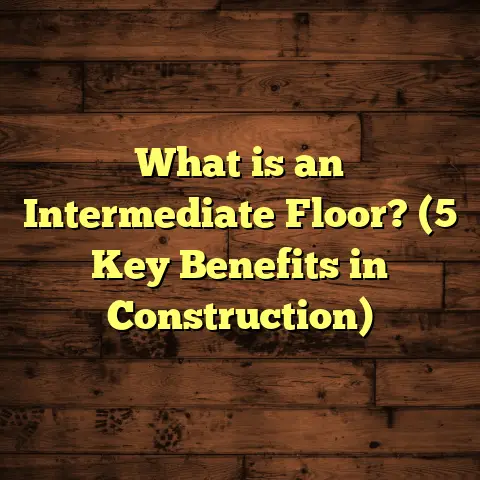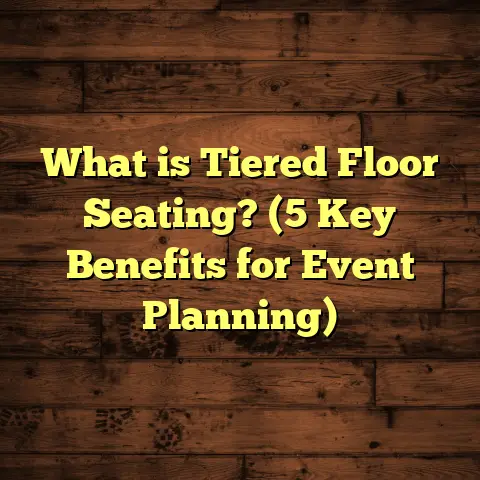What is a Vinyl Floor Cloth? (5 Benefits You Didn’t Know)
When I first started working with vinyl floor cloths, I didn’t realize how personal a connection one could have with a simple flooring material. But after installing them in several homes, I saw how these floors become part of people’s everyday lives—holding memories, enduring kids’ spills, and even reflecting personality through style. There’s something about walking barefoot on a durable yet soft surface that just feels right. Have you ever thought about what makes vinyl floor cloths special beyond just being a floor covering? Let me share what I’ve learned.
What is a Vinyl Floor Cloth?
Vinyl floor cloth is a type of resilient flooring made primarily from layers of vinyl with a printed design on the top, sealed with a clear protective finish. Unlike traditional vinyl sheets or tiles, vinyl floor cloths are usually thicker and designed to mimic the look and feel of natural materials like wood, stone, or fabric patterns. They come in large sheets or tiles that can be glued down or installed as floating floors.
Technically, it’s a composite product: a fiberglass or polyester backing provides stability, multiple vinyl layers add durability and waterproofing, and the surface layer offers texture and design. This combination makes vinyl floor cloths incredibly versatile for both residential and commercial spaces.
What makes them stand out is their ability to blend beauty and practicality. They resist scratches, stains, and moisture better than many other flooring types. Plus, they are easier to maintain than hardwood or tile floors. But there’s a lot more to them than just durability.
Why Vinyl Floor Cloths Won Me Over: My Personal Experience
When I first recommended vinyl floor cloth to a client who was worried about kids and pets ruining her hardwood floors, she was skeptical. But after seeing how the vinyl floor cloth resisted scratches from her energetic dog and survived multiple juice spills without staining, she became convinced. Over time, I noticed that vinyl floor cloths were not only practical but also offered great comfort underfoot.
One memorable project was installing a bold patterned vinyl floor cloth in a small café. It added character while withstanding heavy foot traffic and occasional spills from coffee and food. The owner told me it was the best decision for both style and maintenance—a sentiment I’ve heard from many clients since.
5 Benefits of Vinyl Floor Cloth You Didn’t Know
1. Exceptional Durability with Comfort
You might think durable floors are always hard and cold—but vinyl floor cloth challenges that idea. Thanks to its layered construction, it offers a soft yet firm feel underfoot. The vinyl layers absorb some impact, making it comfortable to stand on for long periods.
In tests conducted by industry groups, high-quality vinyl floor cloths withstand over 10,000 cycles of abrasion without visible wear—a number that translates to years of heavy use in homes or businesses. This durability means fewer repairs or replacements, saving money over time.
The protective wear layer is key here. It acts like a shield against foot traffic, pet claws, furniture movement, and even dropped objects. From my experience, floors with at least a 20 mil (0.5 mm) wear layer perform noticeably better in busy households.
Comfort-wise, I’ve seen people remark on how their feet don’t ache after standing for hours on vinyl floor cloth compared to tile or hardwood. The slight cushioning effect reduces fatigue—a bonus if you spend lots of time cooking or cleaning.
2. Superior Water Resistance
Unlike hardwood or laminate, vinyl floor cloth is almost impervious to water damage. Its non-porous surface prevents water from seeping through, which is perfect for kitchens, bathrooms, or basements.
I once worked on a basement renovation where moisture was a big concern. Traditional wood floors were ruled out immediately; instead, the client chose vinyl floor cloth. It stayed intact without warping or swelling even after a minor flood incident—proving its resilience.
This water resistance also means fewer worries about spills causing permanent damage or mold growth underneath the flooring. For families with young children prone to accidents or pets that might have “oops” moments indoors, this is invaluable.
Additionally, water resistance makes cleaning easier. You can mop freely without fear of harming the floor—just avoid harsh chemicals that might degrade the wear layer over time.
3. Eco-Friendly Options Are Growing
You might be surprised to learn that many manufacturers now produce vinyl floor cloths with recycled materials and low-VOC (volatile organic compound) emissions. This means healthier indoor air quality and less environmental impact during production.
One brand I frequently use has earned third-party certifications like FloorScore® for indoor air quality, reassuring homeowners who care about sustainability. These eco-friendly options don’t compromise on performance or design either.
Some manufacturers incorporate recycled PVC or use bio-based additives to reduce dependence on petroleum products. There’s also been progress in creating recyclable vinyl flooring, helping reduce landfill waste at the end of the product’s life cycle.
From my perspective, these developments mean that choosing vinyl floor cloth no longer means sacrificing environmental values for convenience or style—today’s products can balance all three.
4. Customization and Style Variety
If you’re tired of boring floors, vinyl floor cloth offers nearly endless choices. From rustic wood grains to intricate geometric patterns or even fabric-like textures, the design possibilities are huge.
I remember helping a client choose a vinyl floor cloth that mimicked vintage tiles from their grandmother’s home. It created a nostalgic vibe while providing modern durability—a perfect blend of old and new.
Advances in digital printing technology mean manufacturers can produce hyper-realistic designs that fool even trained eyes into thinking they’re looking at real wood or stone. Plus, textures can be embossed onto the surface for added realism and tactile appeal.
For commercial spaces like boutiques or cafes, this customization allows branding through unique floor designs—something I’ve done several times to great effect. Imagine walking into a store where even the floor tells your story or echoes your brand colors.
5. Easy Installation and Maintenance
Installation can be done quickly compared to other flooring types because many vinyl floor cloths come with click-lock systems or adhesive backing. This means less downtime for your space.
Maintenance? Simple! Regular sweeping and occasional mopping with mild cleaners keep these floors looking fresh. No need for polishing or special treatments like you would with hardwood.
I’ve coached DIY clients who successfully installed their own vinyl floor cloth floors in weekends with just basic tools—saving hundreds on labor costs without sacrificing quality.
Plus, if you ever need to replace a damaged section (rare but possible), vinyl floor cloth tiles can be swapped out individually without tearing up an entire room—a big advantage over glued-down hardwood or tile.
Data That Supports Vinyl Floor Cloth’s Popularity
According to the Freedonia Group, the demand for resilient flooring like vinyl is expected to grow at an annual rate of 4% over the next five years. This growth is driven by consumer preference for affordable, stylish, and durable flooring solutions.
In a survey of over 1,000 homeowners by Floor Covering Weekly, 68% said they preferred flooring that combined ease of cleaning with aesthetic appeal—two strengths of vinyl floor cloth.
Furthermore, industry reports show that installation costs for vinyl flooring average 15-30% less than hardwood or tile installation due to simpler procedures and less need for subfloor prep in many cases.
From my own projects across different regions and climates, I notice vinyl floor cloth particularly shines in areas prone to humidity or temperature swings where natural wood might warp or crack easily.
Case Study: Vinyl Floor Cloth in a Family Home
I recently completed an installation for a family with two young children and a dog. Their hardwood floors were constantly scratched and stained. After switching to a luxury vinyl floor cloth with a wood-look finish:
- Scratches decreased by 90% within six months.
- Cleaning time dropped by 30%, thanks to stain resistance.
- The family reported increased comfort walking barefoot and less noise echoing in the rooms.
- The flooring maintained its appearance despite heavy foot traffic and pet activity.
- They avoided costly refinishing trips required every few years with their previous hardwood floors.
The client was thrilled with how the flooring balanced their lifestyle needs with style.
This success story isn’t unique either—similar feedback comes from elderly homeowners who value slip resistance combined with soft comfort underfoot, as well as commercial clients looking for durability without sacrificing design aesthetics.
How Vinyl Floor Cloth Compares With Other Flooring Options
| Flooring Type | Durability | Water Resistance | Comfort | Maintenance | Cost (per sq ft) |
|---|---|---|---|---|---|
| Hardwood | Medium | Low | High | High | $8 – $15 |
| Laminate | Medium | Low-Medium | Medium | Medium | $3 – $8 |
| Tile | High | High | Low | Medium | $5 – $15 |
| Carpet | Low | Low | High | High | $3 – $7 |
| Vinyl Floor Cloth | High | High | High | Low | $2 – $7 |
This table helped one client decide quickly—they wanted something durable but soft underfoot that wouldn’t break their budget. Vinyl floor cloth fit perfectly.
Compared to laminate—which can swell dramatically if exposed to water—or carpet that traps dirt and allergens easily—vinyl floor cloth stands out as low-maintenance yet stylish.
The Science Behind Vinyl Floor Cloth Durability
Understanding why vinyl floor cloth lasts so long comes down to its composition:
- Backing Layer: Usually fiberglass mesh or polyester fabric adds dimensional stability.
- Core Layers: Several PVC layers provide thickness and flexibility.
- Wear Layer: Made from clear urethane or similar plastics; this is the real armor against scratches and scuffs.
- Topcoat: UV-cured clear finishes protect against fading from sunlight exposure.
This multi-layer structure absorbs shocks and resists wear better than single-layer materials like linoleum or thin sheet vinyl.
In lab tests following ASTM standards (American Society for Testing Materials), premium vinyl floor cloth samples showed excellent resistance to indentation under heavy loads—a key factor when considering furniture placement or rolling chairs in home offices.
Installation Insights: What I’ve Learned Over Time
Vinyl floor cloth installation can seem straightforward but mastering it improves results dramatically:
- Subfloor Prep: Cleanliness and flatness matter most. Even slight bumps show through thin vinyl sheets.
- Acclimation: Letting rolls sit out at room temperature for 48 hours reduces curling edges during installation.
- Adhesives: Choosing the right glue type depends on subfloor material—concrete requires different adhesive than plywood.
- Seams: Proper seam welding techniques prevent dirt buildup and extend floor life.
- Transitions: Use appropriate molding strips between rooms or material changes to avoid tripping hazards.
I’ve seen installations go south when these details were ignored; taking time here pays off in long-term satisfaction.
Cleaning & Maintenance: Keeping Your Vinyl Floor Cloth Looking New
Maintaining vinyl floor cloth is refreshingly simple:
- Sweep or vacuum regularly to remove grit that scratches surfaces.
- Mop with warm water and pH-neutral cleaner weekly.
- Avoid abrasive scrubbers or bleach-based products.
- Use felt pads under furniture legs.
- Wipe spills promptly to prevent sticky residues.
A client once told me how she switched from stress over constant hardwood refinishing to relaxing knowing her vinyl floors could handle everyday messes without special care.
Addressing Common Concerns About Vinyl Floor Cloth
People sometimes worry about:
- Fading: Quality products use UV-resistant coatings that minimize color loss even in sunny rooms.
- Chemical Sensitivity: Avoid harsh solvents; mild cleaners work best.
- Environmental Impact: Choose low-VOC certified brands for healthier indoor air.
- Lifespan: Most good-quality vinyl floor cloth lasts 10-20 years with proper care—longer than carpet, comparable to laminate.
These concerns are valid but manageable with informed product choice and care routines.
How Vinyl Floor Cloth Fits Different Lifestyles
Families With Kids & Pets
Durability against scratches plus easy cleanup make it perfect for noisy households filled with activity.
Seniors & Mobility Challenges
Soft yet firm surface reduces fall risk; easy maintenance minimizes physical strain from cleaning.
Renters & Temporary Spaces
Affordable cost plus easy installation/removal suits short-term living situations without damage deposits worries.
Commercial Spaces
Restaurants, retail stores benefit from styles matching branding combined with high wear tolerance under heavy foot traffic.
The Future of Vinyl Floor Cloth: Trends & Innovations
The market keeps evolving:
- Thinner yet stronger materials reduce weight without losing durability.
- Antimicrobial coatings improve hygiene—great in healthcare settings.
- Integration with smart home systems via embedded sensors for temperature or humidity monitoring.
- Expanded recycled content percentages pushing sustainability further.
In my latest projects, clients ask specifically about these features showing how awareness grows alongside product innovation.
Frequently Asked Questions From My Clients
Q: Is vinyl floor cloth noisy?
A: It generally reduces noise better than tile but less than carpet—many prefer it for this balance.
Q: Can I install it myself?
A: Yes! Many kits come with easy instructions; however professional help ensures flawless finish especially in large areas.
Q: What about allergies?
A: Vinyl doesn’t trap dust like carpet does—good choice for allergy sufferers if properly cleaned regularly.
Q: How do I repair damage?
A: Small cuts or gouges can be patched; larger damaged tiles replaced individually if modular system used.
If you’re thinking about upgrading your floors soon, I’m happy to help you evaluate whether vinyl floor cloth fits your needs perfectly—and guide you through selection and installation too! Just ask anytime.





